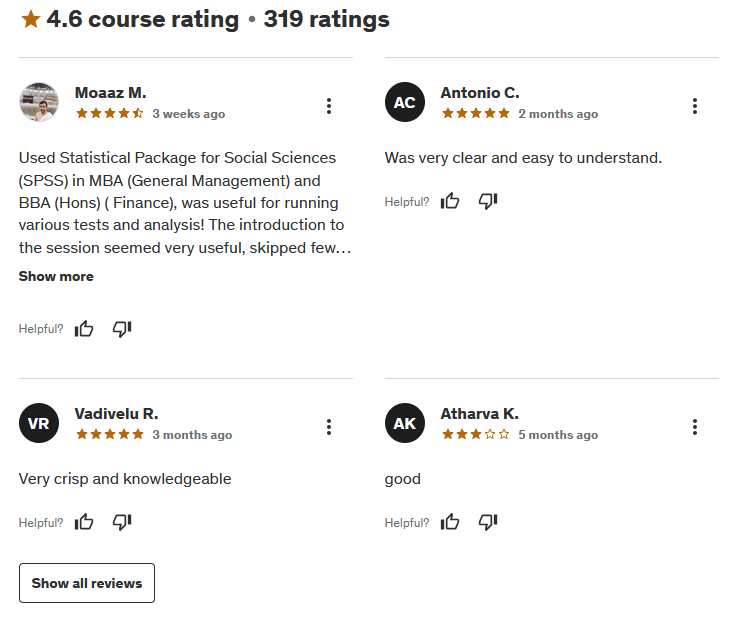If you’ve ever felt overwhelmed by data analysis or unsure where to start, SPSS Data Analysis for Beginning Researchers by Dr. Haoran Zhang might be the perfect course for you. Designed for beginners tackling their first research projects, this Udemy course offers a step-by-step guide to navigating the complexities of data analysis with SPSS. Whether you’re a student, a budding researcher, or just curious about data analysis, this course promises to equip you with practical skills and confidence. But does it deliver? Let’s dive in!
Instructor Reputation
Dr. Haoran Zhang brings an impressive resume to the table, and his extensive background makes him uniquely qualified to teach this course. With a BSc and MPhil in Physics from the Hong Kong University of Science and Technology and a Doctor of Education (EdD) from the University of Bristol, Dr. Zhang blends technical expertise with advanced pedagogical methods. His specialization in flipped classrooms and active learning ensures his courses are designed with modern educational practices in mind, catering to different learning styles.

Dr. Zhang has been teaching statistics and data analysis at the university level since 2004, and his focus has primarily been on students from non-technical backgrounds. This is crucial because many learners approaching SPSS and statistics are intimidated by the technical jargon and complex formulas. Dr. Zhang excels at breaking down these barriers, using clear language and real-world examples to make challenging concepts more approachable.
His approach has garnered glowing reviews from students, with a solid 4.6 instructor rating on Udemy. Learners often praise his ability to take a potentially overwhelming subject and make it manageable, highlighting his knack for explaining core ideas without unnecessary complications. His responsiveness also stands out—students frequently mention how he actively engages with their questions, providing thoughtful answers and additional guidance.
Beyond his technical expertise, Dr. Zhang’s passion for teaching shines through in the course materials. He doesn’t just aim to instruct but to empower his students, giving them the tools they need to conduct data analysis independently. His experience working with students struggling to complete research projects makes him empathetic to their challenges, and he tailors his teaching to address common pain points. For instance, many learners feel lost when faced with missing or invalid data. Dr. Zhang anticipates these issues and integrates practical solutions into his lessons, ensuring that students can navigate these hurdles confidently.
It’s also worth noting that Dr. Zhang’s academic rigor is balanced by a friendly and approachable demeanor, making the learning process enjoyable. His Twitter presence further emphasizes his willingness to engage with students and foster a community of learners. This blend of technical skill, teaching experience, and personal investment in his students’ success sets Dr. Zhang apart as an instructor.
Course Structure
The structure of SPSS Data Analysis for Beginning Researchers is one of its strongest features. Designed with beginners in mind, the course takes learners on a well-paced journey from understanding foundational concepts to applying them in real-world scenarios. This deliberate progression ensures that even those with no prior experience in data analysis can follow along comfortably.
Each section of the course is thoughtfully designed to build on the last. Dr. Zhang begins with a brief overview of key statistical concepts, ensuring learners have the necessary theoretical foundation. However, this is not a dry, academic introduction—Dr. Zhang knows his audience. He distills complex topics into simple, digestible explanations that focus only on the essentials. This is particularly helpful for beginners who might otherwise feel overwhelmed by the breadth of statistical knowledge available.
From there, the course moves into practical demonstrations, which are the heart of the learning experience. Every video showcases a specific data analysis task, carefully selected to reflect common real-world scenarios. For instance, learners might explore how to clean data, choose the appropriate analysis method, or conduct hypothesis tests. These tasks are not just hypothetical—they are grounded in realistic challenges that researchers often face, making the lessons immediately applicable.
Another standout feature is the course’s emphasis on interactivity. Each section ends with an exercise designed to reinforce the concepts covered. These exercises are more than busywork; they challenge learners to think critically about the material and apply it to new situations. For example, an exercise might prompt students to identify the correct statistical test for a given dataset or troubleshoot common data errors. This active engagement deepens understanding and builds confidence.
Dr. Zhang also provides solution videos for the exercises, walking learners through the correct answers step by step. This feature is particularly valuable because it allows students to compare their work with a clear example. If discrepancies arise, learners can analyze why and adjust their approach. This feedback loop fosters a deeper learning experience and helps students develop problem-solving skills that will serve them well in their research projects.
Key takeaways are highlighted throughout the videos, ensuring that learners don’t miss important points. These are often presented as summaries or quick tips, making them easy to remember. Additionally, Dr. Zhang shares practical advice based on his own experience, such as how to deal with missing data or avoid common mistakes when using SPSS. These insights add a layer of value that goes beyond textbook knowledge.
For those who want to dive deeper into the material, the course includes links to external references. This optional content allows learners to explore advanced topics at their own pace without feeling pressured to grasp everything at once. This flexibility makes the course suitable for a wide range of learners, from absolute beginners to those with some prior knowledge looking to solidify their understanding.
The course’s design also prioritizes efficiency. Dr. Zhang focuses on the “minimal set of knowledge” needed to conduct data analysis, avoiding unnecessary details that might confuse beginners. However, this doesn’t mean the course is shallow. On the contrary, it provides a robust foundation that prepares learners for more advanced studies or real-world applications.
Overall, the course structure reflects Dr. Zhang’s expertise not just as a statistician but as an educator. It balances theory and practice, challenge and support, making it an ideal starting point for anyone new to data analysis. Whether you’re a student working on a research paper or someone curious about data analytics, this course offers a clear, practical pathway to success.
Content Quality
The content quality of SPSS Data Analysis for Beginning Researchers is one of the key strengths of this course. Dr. Haoran Zhang has carefully crafted each module to provide a clear and structured path for learners, which makes the course both comprehensive and highly accessible. The content is rich in practical applications, but it doesn’t overwhelm beginners with excessive technical jargon. Dr. Zhang strikes an excellent balance between theory and practice, ensuring that each concept is tied to real-world data analysis tasks that learners are likely to encounter in their research.

Each lesson is packed with high-quality visuals and demonstrations. The course doesn’t rely solely on abstract theories or complicated formulas but instead gives learners step-by-step guidance on how to perform specific tasks within SPSS, such as data cleaning, hypothesis testing, and conducting basic statistical analyses. This practical approach is reinforced by Dr. Zhang’s clear and effective explanations. He consistently uses simple language without sacrificing the integrity of the concepts being taught. This accessibility is critical for beginners who may feel daunted by the prospect of learning both statistics and a complex tool like SPSS simultaneously.
The course goes beyond just teaching how to use SPSS—it also explains why specific methods and techniques are used in data analysis. Dr. Zhang provides context for every tool and statistical concept, helping learners understand how different analyses are applied to answer research questions. For example, when teaching about hypothesis testing, Dr. Zhang doesn’t just show how to run a t-test in SPSS. He explains the theory behind the test, when it should be used, and what the results mean in the context of a research study. This holistic approach ensures that students are not just following steps without understanding their significance.
The video tutorials are well-paced and concise, with each one focusing on a specific skill or concept. This modular structure allows students to digest content in manageable chunks, making it easy to review individual sections if needed. The pace of the course is ideal for beginners—there’s no rush, and Dr. Zhang takes the time to explain concepts in detail while avoiding excessive repetition. This makes the learning process engaging rather than overwhelming, which is particularly beneficial for students who may be new to the subject matter.
One of the most appreciated features of the content is the focus on common data analysis pitfalls and how to avoid them. Data analysis can be fraught with challenges, especially for beginners, such as dealing with missing data, invalid values, or the temptation to run inappropriate tests. Dr. Zhang shares his extensive experience handling these issues, offering practical advice on how to troubleshoot data and SPSS errors. He doesn’t just teach you how to use the software; he teaches you how to think critically about the data and make informed decisions throughout the analysis process.
Another strong aspect of the content is its interactivity. The course includes multiple exercises designed to reinforce the material learned in each module. These exercises are not just busywork—they help students consolidate their knowledge and apply the skills they’ve just learned to new problems. Dr. Zhang also provides a solution video for every exercise, demonstrating the correct way to approach each problem. This feature is invaluable for reinforcing learning, as students can compare their approach to Dr. Zhang’s method and identify areas for improvement.
Lastly, the course includes external references for students who wish to dive deeper into specific statistical concepts or SPSS features. These resources add an extra layer of depth for learners who may be curious about advanced topics, ensuring that the course caters not only to beginners but also to those who may want to continue their studies beyond the scope of the lessons. This aspect of the course demonstrates Dr. Zhang’s commitment to providing value at every level of the learning journey, not just at the surface level.
Overall, the content quality is exceptional for beginners in data analysis. It provides a clear, well-organized roadmap for mastering SPSS and understanding the basics of statistical analysis, all while keeping things practical and user-friendly. The lessons are comprehensive without being overwhelming, and the emphasis on real-world application makes the course relevant to anyone starting their research journey.
Overall Course Rating – 9/10
Overall, SPSS Data Analysis for Beginning Researchers by Dr. Haoran Zhang is an outstanding resource for anyone new to data analysis, especially those looking to use SPSS for their research. The course earns a solid 9/10 rating, which reflects its effectiveness, accessibility, and the wealth of practical insights it offers learners. Here’s a breakdown of why this course earns such a high rating.

Ease of Learning (9/10): Dr. Zhang’s teaching style makes the learning process incredibly easy for beginners. His use of clear language and simple explanations ensures that even students without a technical background can grasp complex statistical concepts. The course structure allows learners to build knowledge step by step, without feeling overwhelmed. However, the course is designed for those with little to no prior experience in statistics or SPSS, so for more advanced learners, it might feel somewhat slow-paced. Still, beginners will find it incredibly valuable.
Content Depth (8/10): While the course covers a wide range of fundamental topics, there is a natural limit to how deeply it can go due to its beginner focus. Dr. Zhang does an excellent job of covering the essentials without veering into too much detail, which is perfect for first-time researchers. However, those seeking an in-depth, advanced study of SPSS or statistics may find themselves wanting more. For example, while the course offers a solid introduction to hypothesis testing and common statistical methods, more complex analysis techniques are not the focus.
Practical Application (9/10): The course excels in its practical, hands-on approach. Students are guided through real-world examples and exercises that mimic the challenges researchers face in actual data analysis. The exercises are particularly useful, as they encourage active learning and provide a direct application of the theory. Dr. Zhang’s emphasis on common issues, like handling missing data and choosing the right statistical test, ensures that students are prepared for real research scenarios.
Instructor Engagement (10/10): One of the standout aspects of this course is Dr. Zhang’s involvement and engagement. He is highly responsive to student queries and goes the extra mile to ensure that learners understand the material. The solution videos for exercises are a huge benefit, as they help reinforce the content and provide clarity where needed. Additionally, Dr. Zhang’s passion for teaching and his clear enthusiasm for data analysis make the course enjoyable to follow.
Student Satisfaction (9/10): With a 4.6 out of 5 rating and positive feedback from over 4,000 students, it’s clear that many learners find this course extremely helpful. The reviews highlight Dr. Zhang’s teaching effectiveness and the course’s ability to simplify a complex topic. The course has helped numerous students complete their research projects with confidence and avoid common data analysis mistakes. However, as with any course, some students with prior knowledge in SPSS or statistics might not find it as challenging, though they can still benefit from the well-structured lessons.
Overall Rating: 9/10
This course is an excellent starting point for anyone who is new to data analysis and wants to learn how to use SPSS effectively. It provides a great blend of theory, practical examples, and hands-on exercises that ensure students can apply what they’ve learned to their own research projects. Dr. Zhang’s approachable teaching style and the course’s well-paced structure make it an ideal choice for beginners. If you’re looking for an entry-level data analysis course that will help you master SPSS without feeling overwhelmed, SPSS Data Analysis for Beginning Researchers is a fantastic option.




